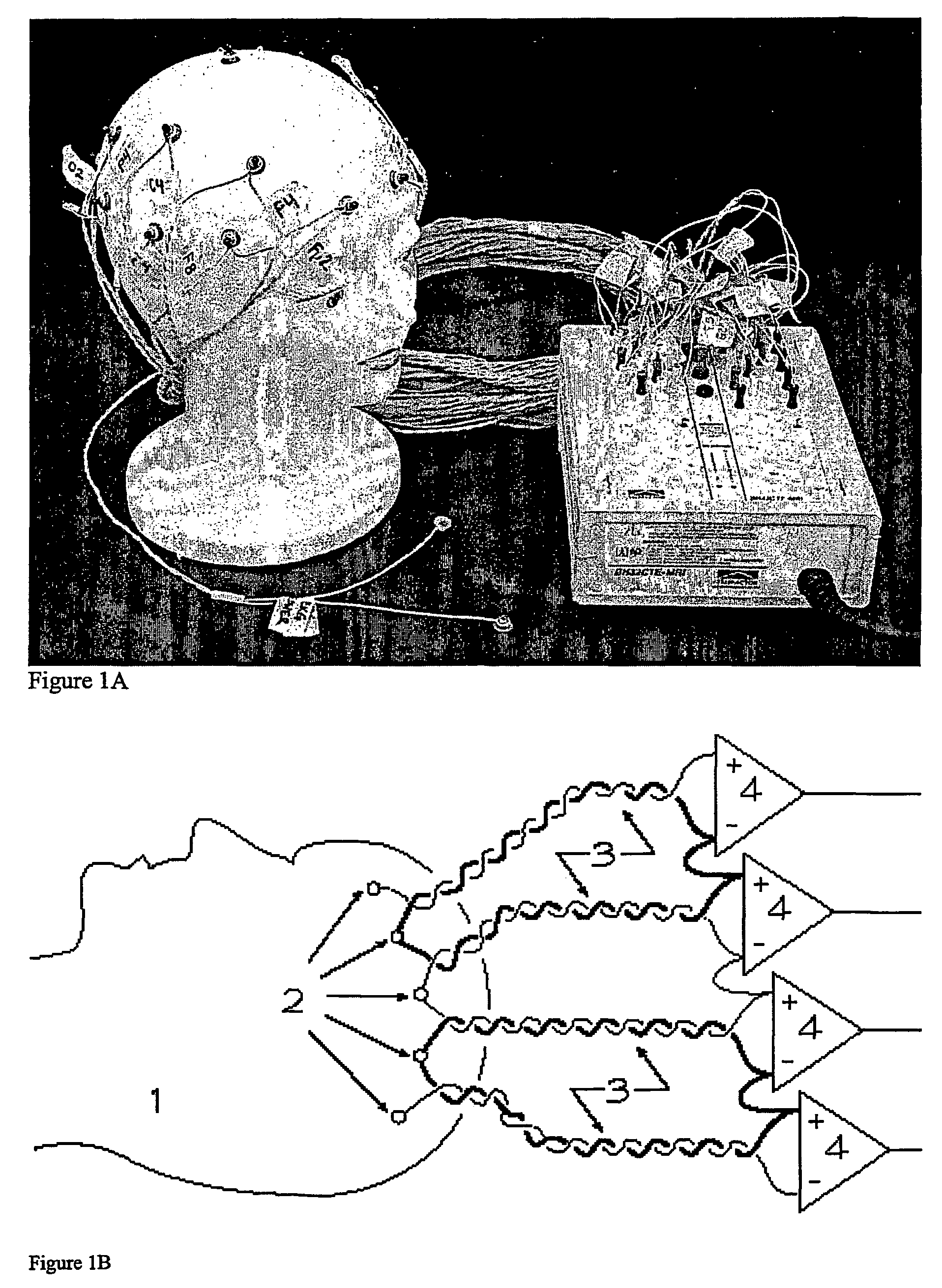Method and apparatus for reducing contamination of an electrical signal
- Summary
- Abstract
- Description
- Claims
- Application Information
AI Technical Summary
Benefits of technology
Problems solved by technology
Method used
Image
Examples
example 1
Acquiring Simultaneous EEG and Functional MRI
Methods
[0104]The EEG device incorporates numerous hardware modifications to reduce artifact in concurrent EEG / fMRI, and was provided by Telefactor Corporation (W. Conshohocken, Pa.). Signal is detected from the, scalp using silver chloride plated plastic cup electrodes connected to a compact magnet-compatible local amplifier (headbox) via 10 foot carbon fiber leads with a resistance of 1 kΩ / foot. This design minimized both artifact in the MR images and the induction of RF current loops in the lead wires.
[0105]A lead configuration was devised that minimized unwanted current induction by recording EEG in a hard-wired montage using special dual lead electrodes. The lead wires from each electrode pair were twisted together over their entire length, forming a chained bipolar montage for each hemisphere (fp2-f8, f8-t4, t4-t6, t6-o2, o2-p4,p4-c4, c4-f4, f4-fp2; fp1-f7, f7-t3, t3-t5, t5-o1, o1-p3, p3-c3, c3-f3, f3-fp1...
example 2
Method for Removal of Artifacts in Simultaneous EEG and fMRI
[0129]The strategy outlined below is applicable to any method involving digital subtractive noise cancellation, including EEG, EEG / fMRI, as well as any environment in which subtracted averages of artifacts are used to reduce noise.
Methods
EEG Recording and Electrode Placement
[0130]The basic approach of differential recording has been described previously (Goldman, Cohen et al. 2000; Goldman, Stern et al. 2000). Paired silver electrodes are placed on the scalp surface attached with conductive electrode gel and check to ensure that the nominal impedance is less than 5 kΩ for each electrode. The electrodes are themselves attached to two carbon fiber conductors having a distributed resistance of approximately 3 kΩ / m The wires are dressed in pairs with the leads from adjacent electrodes twisted together tightly to minimize electromagnetic pickup. This configuration offers about 6 dB attenuation of artifacts from gradient and ball...
example 3
Increasing Dynamic Range Available in Digitized Electro-Encephalographic Signals
[0153]The scalp electrical potentials used in the EEG contain both time varying and static (DC) components. Often the DC offset is much larger than the EEG, but it is seldom of interest for clinical diagnostic purposes, as it contains essentially no information. However, it does cause trouble as it increases the dynamic range needed to digitize the EEG signal. For example, the EEG may be only a few microVolts (μV), while potentials of several tens of milliVolts (mV) may exist between electrodes, or as a result of the chemical electrode potential developed when the electrode is in contact with the scalp. The depth of the signal digitization will be reduced by the ratio of the EEG to the DC potential: assuming a DC offset of 10 mV, an EEG signal of 10 μV, and a 12 bit analog to digital converter (ADC), the 4096 different levels representable by the ADC will be reduced to only 4 levels for the EEG. Clearly...
PUM
 Login to View More
Login to View More Abstract
Description
Claims
Application Information
 Login to View More
Login to View More - R&D
- Intellectual Property
- Life Sciences
- Materials
- Tech Scout
- Unparalleled Data Quality
- Higher Quality Content
- 60% Fewer Hallucinations
Browse by: Latest US Patents, China's latest patents, Technical Efficacy Thesaurus, Application Domain, Technology Topic, Popular Technical Reports.
© 2025 PatSnap. All rights reserved.Legal|Privacy policy|Modern Slavery Act Transparency Statement|Sitemap|About US| Contact US: help@patsnap.com



